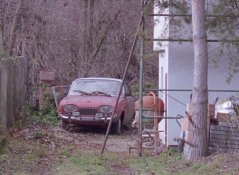Heinz_Anderle
Member
Fujicolor C200 (also sold as Z200) is a budget-priced film, available fresh in large quantity mostly in double- or four-packs, with an outstanding latitude. A German "Stiftung Warentest (Product test foundation)" comparison of several consumer films in 2004 revealed a useful exposure range from - 1 5/6 to + 3 5/6 f-stops for C200. C200 can be exposed at the box speed, as overexposure is not necessary for shadow detail.
In the shadows grain remains as fine as in the highlights. Grain, sharpness and color rendition are all together excellent, and scanning (at least at home, see below) profits from a moderate mask density. Fluorescent lamps do not show a pronounced cyan cast, so that four layer-technology appears to be itegrated also in this film. Color saturation comes quite close to Astia 100F, but with a much better shadow detail. Who could wish for more.
I however got back with my last processed Z200 film also prints (10 x 15 cm = 4 x 6 ") which I hadn't ordered, for a good reason: Contrast and colors had been enhanced with a strange orange/cyan cast. The shadows had lost all their details by turning into a cyan-black mass. It looked like a sort of - pardon me - deliberate "velviation" only in color saturation and contrast, but not in color accuracy, sharpness and detail, as oblique lines such as power wires showed visible pixel stepping, and fine details such as grass or twigs were smeared, as if they had be downscaled to camera-cell phone resolution. On the first sight it became clear, also by the Kodak Royal Digital paper used, that the prints came from a scanning printer with automatic software "correction".
The premium developing service which I always choose for processing claims to enhance and "optimize" those pictures digitally for printing. I returned all the prints and scanned the negatives on my own to get what I wanted.
There is not much choice any more. In a recent comparison test of several internet upload print labs, colors and contrast were more characteristic for the lab than for the image. In film-based analog photography, one should expect more consistent results, but with such a poor quality of premium-priced prints I fear that even the remaining occasional photographers will feel forced to go digital, as they may never see the difference between a fully resolved 24 x 36 mm color negative and and a camera cell-phone any more...
In the shadows grain remains as fine as in the highlights. Grain, sharpness and color rendition are all together excellent, and scanning (at least at home, see below) profits from a moderate mask density. Fluorescent lamps do not show a pronounced cyan cast, so that four layer-technology appears to be itegrated also in this film. Color saturation comes quite close to Astia 100F, but with a much better shadow detail. Who could wish for more.
I however got back with my last processed Z200 film also prints (10 x 15 cm = 4 x 6 ") which I hadn't ordered, for a good reason: Contrast and colors had been enhanced with a strange orange/cyan cast. The shadows had lost all their details by turning into a cyan-black mass. It looked like a sort of - pardon me - deliberate "velviation" only in color saturation and contrast, but not in color accuracy, sharpness and detail, as oblique lines such as power wires showed visible pixel stepping, and fine details such as grass or twigs were smeared, as if they had be downscaled to camera-cell phone resolution. On the first sight it became clear, also by the Kodak Royal Digital paper used, that the prints came from a scanning printer with automatic software "correction".
The premium developing service which I always choose for processing claims to enhance and "optimize" those pictures digitally for printing. I returned all the prints and scanned the negatives on my own to get what I wanted.
There is not much choice any more. In a recent comparison test of several internet upload print labs, colors and contrast were more characteristic for the lab than for the image. In film-based analog photography, one should expect more consistent results, but with such a poor quality of premium-priced prints I fear that even the remaining occasional photographers will feel forced to go digital, as they may never see the difference between a fully resolved 24 x 36 mm color negative and and a camera cell-phone any more...


















